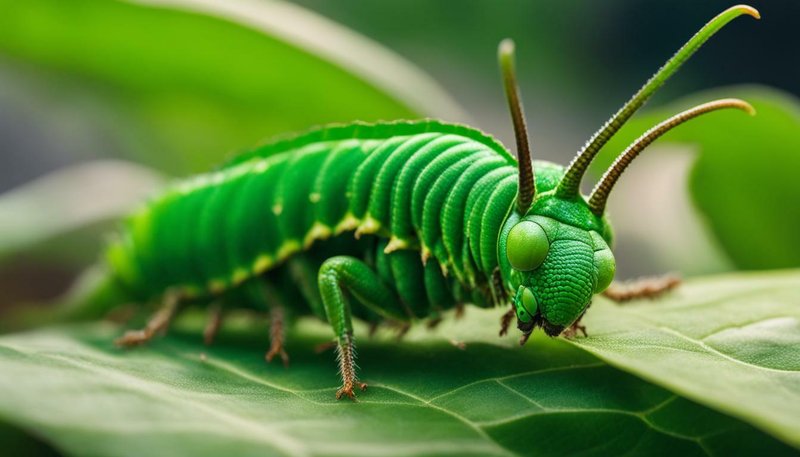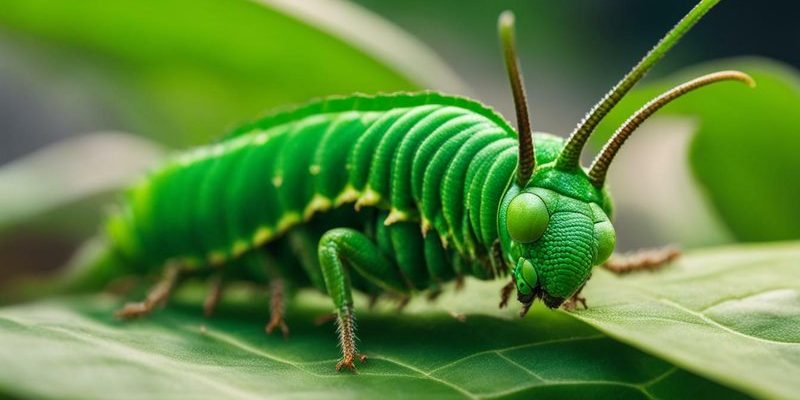
Let’s dive into what makes hornworms unique and how to handle them safely. You might think these wriggly critters are just a food source, but treating them with care goes a long way in ensuring they thrive before becoming a delicious meal. Could you imagine serving up dinner without washing your hands? It’s a similar thought when it comes to hornworms—they deserve respect too!
Understanding Hornworms: A Quick Overview
Hornworms, particularly the ones from the *Manduca* family, are often used in reptile diets. They’re known for their vibrant, green bodies and a distinctive horn-like protrusion on their rear end, hence the name. You might find them in pet stores sold as feeders, but they’re also super popular among gardeners because they can become pesky little caterpillars in the garden.
In terms of appearance, these worms can grow quite large—up to 4 inches long! You might be wondering how these little guys fit into pet care. Well, they’re an excellent source of protein and fat for those cold-blooded companions. But, with great snacks come great responsibilities. Knowing how to handle them safely is essential for both your health and your pet’s well-being.
Why Safe Handling Is Crucial
Here’s the thing: hornworms may not seem dangerous, but improper handling can lead to various issues. For starters, they can carry bacteria that could cause infections. Plus, if you’re not careful, you might accidentally crush one while reaching for another. And trust me, nobody wants worm juice on their hands!
Additionally, if you’ve got a few hornworms in a container, you’ve got to ensure they’re in a suitable environment. Handling them with care prevents unnecessary stress on the worms, promoting better health and nutritional value when they finally make it to your pet’s dish. So, let’s be responsible caretakers, shall we?
Preparing Your Workspace
Before you even lay a finger on a hornworm, it’s essential to set up a clean and safe workspace. Think of it as making a perfect sandwich; you wouldn’t want crumbs from that last lunch getting mixed in, right? Here’s how to prepare your area:
- **Choose a clean surface:** Make sure your workspace is free from dirt or chemicals. A simple kitchen counter or a clean table works well.
- **Gather your tools:** You’ll need gloves, a bowl for the worms, and maybe a soft brush. It’s kind of like having the right tools when you bake; each one plays a part!
- **Wash your hands:** Before and after handling hornworms, wash your hands with soap and water. This ensures you keep both your hands and the worms happy.
Setting the stage properly can help avoid any mishaps later on. Plus, it gives you a little peace of mind knowing you’re working in a safe environment.
Handling Hornworms Safely
When it comes time to actually handle the hornworms, it’s all about finesse. Think of it like cradling a baby bird—gentle yet firm. Here’s how you can do it:
- **Use gloves:** First off, put on a pair of gloves. This isn’t just for hygiene; it also ensures you don’t accidentally hurt the worm while picking it up. Plus, it makes the cleanup easier!
- **Pick them up gently:** Use your fingers or a soft tool, like a soft brush, to lift the hornworms. Avoid squeezing them too hard; they might not be jelly, but they’re delicate!
- **Keep them contained:** If you need to move them between containers, be careful not to drop them. They’re great climbers, and losing one could be a nuisance.
Taking your time during this step is key. Hornworms are surprisingly resilient, but they can be stressed if handled too roughly.
Feeding Your Hornworms: What You Need to Know
Before you serve those hornworms to your pets, let’s talk about their diet. Feeding them the right things is crucial for their health—and it directly affects your pet’s nutrition too! Hornworms thrive on fresh, nutritious greens. Here’s how to keep them well-fed:
- **Choose fresh leaves:** Offer them things like mulberry leaves, dandelion greens, or even a mixture of high-quality vegetable scraps.
- **Avoid harmful foods:** Things like potato leaves or tomato plants can be toxic. Stick to safe options to keep your hornworms healthy.
- **Hydration is key:** Ensure they have some moisture in their container, but don’t drown them. A damp sponge or a small piece of fruit can do the trick.
By providing a balanced diet for your hornworms, you’re not just helping them thrive; you’re also ensuring your pet gets a nutritious meal.
Cleaning Up After Handling Hornworms
Once you wrap up your time with the hornworms, it’s important to clean up properly. Just like any kitchen task, you don’t want to leave behind a mess. Here’s how to do it:
- **Dispose of any uneaten food:** Leftover greens can spoil quickly and attract unwanted pests, so toss any uneaten bits.
- **Wash your tools:** Clean your gloves and any equipment you used with warm, soapy water. This prevents any bacteria from lingering.
- **Sanitize your workspace:** Wipe down the surface you worked on with a disinfectant. Keeping a clean area is always a good practice!
Being meticulous about cleanup helps maintain both your health and your pet’s well-being. Plus, it creates a great habit for future sessions.
Common Issues and Troubleshooting
Even with the best practices, you might run into some hiccups when handling hornworms. Here are a few common issues and how to tackle them:
- **Worms escaping:** If a hornworm manages to wriggle away, don’t panic! They blend in well, but take a moment to scout the area carefully—check under tables or any nooks.
- **Unhealthy appearance:** If your hornworm looks shriveled or discolored, it might be a sign of stress or disease. Ensure you’re feeding them properly and they’re in a suitable environment.
- **Container cleanliness:** If you notice a smell coming from the container, it may need a thorough cleaning or a change of bedding. Regular monitoring is key.
Being aware of these potential problems helps you act quickly, ensuring both your pets and worms stay healthy.
Final Thoughts on Handling Hornworms
Caring for hornworms doesn’t have to be daunting. With the right practices, you can handle them safely and ensure they’re well-prepared for your pets. Think of it this way: hornworms are just another part of your pet care routine, like feeding and cleaning. Treat them with respect, keep your workspace tidy, and always prioritize hygiene.
By following these safe handling practices, you’re not just ensuring your worms are healthy; you’re also contributing to your pet’s overall health. So, next time you’re getting ready to feed your scaly friend, remember that those little green worms deserve a little TLC too!

